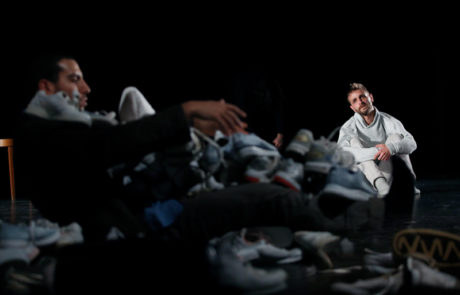In the Western tradition, we have been educated that our human condition is essentially binary: female versus male; good versus bad; mind versus body. However, whether we consider these polarities in opposition or as complimentary, there is always a third element involved, which is the relationship between them, the hyphen that links them.
As such the number three is a much more adequate number to understand ourselves: beginning, middle, end; birth, life, death; the three dimensions of space (length, width, height) and time. It is the threesome of past, present and future or how we are always a link ourselves between our parents and the next generation.
It is no coincidence that the number three figures so prominently in fairytales (three bears, three pigs) and myths (the three Fates, the three-headed dog Cerberus). The figure three is archetypical and always announces a sense of wholeness and completion through embracing synthesis.
In many rituals, actions need to be repeated three times. In a similar way in Indian classical dance, they celebrate the principle of ‘ti-ha’, which literally means ‘three times’ and implies that you should repeat every movement at least three times. The first time to introduce it, the second time to recognize it and the third time, to enjoy it. And wasn’t it Cunningham who stated that you can only speak of the art of choreography, the moment at least three bodies are on stage?
Three Ages, the new creation of Cie Idem explores all of the above both thematically and formally. Thematically Three Ages presents three male figures: The Man in Color, the present torn between the Man in White (his past memories) and the Man in Black (his future). Each age is characterized by its own physicality and movement quality. At different ages, we also have different energies and rhythms: the vigor of youth versus the tiredness of old age. But in order to stay grounded and enjoy the present, we have both to accept our past and not be too anxious about our future. If we are able to integrate these ‘three ages’, we are able to create and live in the flow of our own movements.
Formally, the original inspiration of Three Ages was to translate the concept of a Triptych from visual arts into dance. Three Ages consists of a series of solos, duets and trios. In the solos, the three figures reveal part of their identity. In the duos they engage with each other in different ways: intervening, hindering, pulling back, pushing forward, manipulating, lifting, supporting,… In doing so they contaminate each other and the black and white reveals shades of grey. But it is only in the trios that they find a unity and wholeness. Like the cogwheels of a clock, they need each other to function, to move together.
Guy Cools – Dramaturge
Matthias Kass (choreographer & director)
Clément Bugnon (choreographer)
Samir M’kirech, Mattia Saracino and Simone Frederick Scacchetti (dancers)
Stefano Roveda (assistant)
Guy Cools (dramaturgical coach)
Szymon Brzóska (composer)
Barbara Drążkowska (pianist)
Victor Guaita (violinist)
Besim Morina (light & stage design)
Matthias Rieber (video)
Ida Zenna (photographer)
Co-production: Théâtre Benno Besson






















